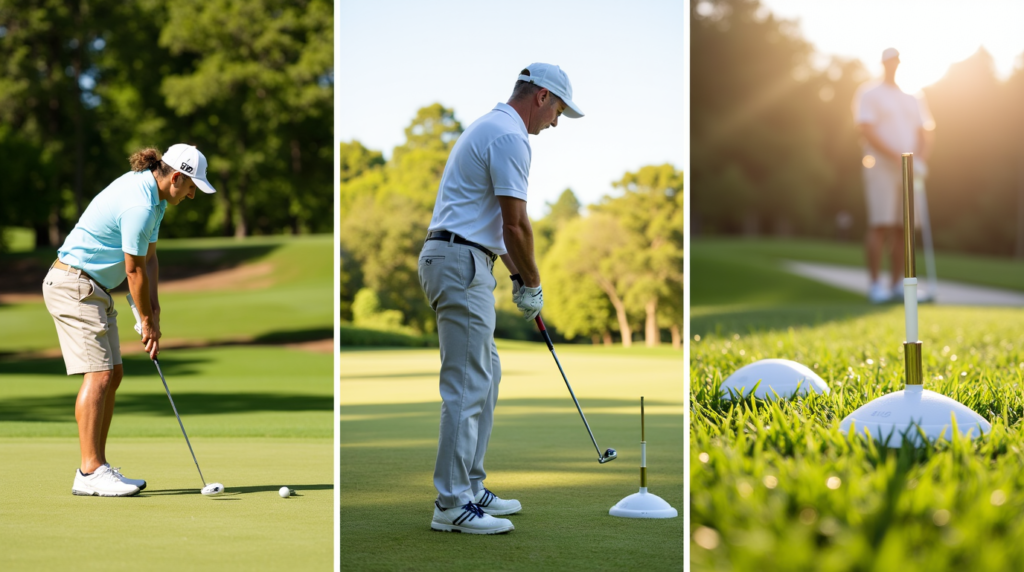Golf

The Basic Golf Swing: Fundamentals for Beginners
The golf swing. It’s a movement that has been analyzed, dissected, and debated for centuries. For beginners, it can seem like an incredibly complex and unnatural motion. But at its heart, the golf swing is based on a few key fundamentals. Forget trying to copy tour pros right away; let’s break down the basic golf swing into manageable pieces and build a solid foundation that you can grow from. Think of it like learning to walk before you run – mastering the fundamentals is the key to unlocking your golfing potential.
1. The Foundation: Grip, Stance, and Posture
These three elements are your pre-swing setup, and they are absolutely crucial for a consistent and effective swing. Get these right, and you’re already halfway there!
The Grip: Your Connection to the Club: The grip is your only physical connection to the golf club, so it’s vital to get it right.
Neutral Grip: For beginners, a neutral grip is generally recommended. Imagine holding a hammer or shaking hands with the club. Your hands should work together as a unit.
Pressure: Grip pressure should be light to medium, like holding a bird – firm enough to control it, but not so tight you’ll crush it! Tension in your grip restricts swing fluidity.
Overlapping or Interlocking: Experiment with either an overlapping (Vardon) grip or an interlocking grip. Neither is inherently better for beginners, it’s about what feels most comfortable and connected.
The Stance: Balance and Stability: Your stance provides the base for your swing.
Width: Stand with your feet roughly shoulder-width apart. For longer clubs (driver), you might widen your stance slightly for more stability. For shorter clubs (wedges), you can narrow it a bit for more control.
Weight Distribution: Distribute your weight evenly on the balls of your feet. You should feel balanced and athletic, ready to move.
Ball Position: Ball position varies slightly depending on the club. For a driver, the ball is typically positioned off your lead heel (left heel for right-handed golfers). As clubs get shorter, the ball position moves slightly towards the center of your stance. For mid-irons (like a 7-iron), the ball is generally in the center of your stance.
Posture: Athletic and Ready to Swing: Good posture sets the stage for a fluid swing motion.
Spine Angle: Bend from your hips, keeping your back relatively straight (not rounded). Think of maintaining a slight spine angle throughout your swing.
Knees: Slightly flex your knees – not too stiff, not too bent. This allows for athletic movement and weight transfer.
Arms Hanging Naturally: Let your arms hang naturally down from your shoulders. Avoid reaching or straining.
2. The Backswing: Coil and Load Power
The backswing is where you coil your body and store energy to unleash in the downswing.
One-Piece Takeaway: Start the backswing by moving your shoulders, arms, and hands together as a unit. Avoid just lifting your arms or wrists initially. Think of your shoulders starting the motion.
Shoulder Turn: Turn your shoulders away from the target, allowing your hips to turn naturally as well (but less than your shoulders). You’re aiming for a good shoulder turn while keeping your weight balanced.
Weight Shift (Subtle): As you turn back, your weight will naturally shift slightly to your back foot (right foot for right-handers). Don’t force a massive weight shift, it should be a natural consequence of the shoulder turn.
Top of the Swing: Aim to get your lead shoulder (left shoulder for right-handers) under your chin at the top of your backswing. Your wrists will naturally hinge as you swing back. Avoid overswinging – a controlled, comfortable backswing is better than a long, uncontrolled one.
3. The Downswing and Impact: Unleash the Power
The downswing is where you transfer the energy you stored in the backswing into the golf ball.
Sequence is Key: The downswing is a sequence of movements, starting from the ground up. Weight shifts to your lead foot, then hips rotate, then torso, then arms and hands, and finally the clubhead. Think «legs, hips, core, arms, hands, club.»
Weight Transfer: Initiate the downswing by shifting your weight back to your lead foot. This helps generate power and stability.
Hip Rotation: Your hips should start to rotate towards the target, leading the downswing. This creates space for your arms to swing through.
Arms and Hands Follow: Your arms and hands follow the rotation of your body, swinging down naturally. Avoid trying to «hit» at the ball with your hands. Let your body rotation power the swing.
Impact: At impact, your weight should be mostly on your lead foot, and your hands should be slightly ahead of the ball. You’re aiming to compress the ball against the clubface.
4. The Follow-Through: Balance and Finish
The follow-through is not just the end of the swing; it’s a reflection of a balanced and complete motion.
Balanced Finish: Finish your swing in balance, with most of your weight on your lead foot. You should be able to hold your finish position.
Full Extension: Your arms should extend fully through the ball, pointing towards the target.
Belt Buckle Facing the Target: Your belt buckle should be facing the target in your finish position, indicating a full body rotation.
Common Beginner Mistakes to Avoid:
Gripping too tightly: Leads to tension and restricted swing.
Trying to hit the ball too hard: Focus on smooth, controlled swings.
Lifting your head: Keep your eye on the ball during the swing.
Swaying instead of turning: Maintain your balance and rotate around your spine.
Overthinking: Keep it simple, focus on the fundamentals, and don’t get bogged down in too many swing thoughts.
Practice and Patience are Key:
Learning the golf swing takes time and practice. Don’t expect to master it overnight. Focus on practicing these fundamentals consistently. Start slowly, build good habits, and gradually increase your swing speed and complexity as you improve. And remember, even the pros are constantly working on their swing!

Improving Your Golf Game: Practice Tips and Drills for All Skill Levels
Want to shave strokes off your score and play better golf? Practice is the answer! But not all practice is created equal. Mindless ball-beating can be unproductive. This section will provide you with effective practice tips and drills tailored to different skill levels, covering all aspects of your game – from driving to putting. Let’s transform your practice sessions into game-improving workouts!
Practice Principles for All Levels:
Practice with Purpose: Before each practice session, have a specific goal in mind. What aspect of your game are you working on? What do you want to improve?
Quality over Quantity: Focus on making quality swings and repetitions, rather than just hitting a bucket of balls mindlessly. Concentration is key.
Simulate Course Conditions: Practice different types of shots you’ll encounter on the course – uphill lies, downhill lies, sidehill lies, shots from the rough, etc.
Track Your Progress: Keep a practice journal or use a golf app to track your progress. This helps you identify areas where you are improving and areas that still need work.
Warm-up Properly: Always start with a proper warm-up before practicing or playing to prevent injuries and prepare your body for the swing motion.
Practice Tips and Drills by Skill Level:
Beginner Level:
Focus on Fundamentals: Grip, stance, posture, and basic swing mechanics are your priority.
Driving Range Focus: Spend most of your time at the driving range working on full swings with irons (7-iron is a great starting point) and fairway woods.
Putting Green Basics: Practice basic putting strokes for distance control and consistency. Focus on smooth, pendulum-like strokes.
Chipping Practice (Short Game Area): Learn basic chipping technique, focusing on making clean contact and controlling distance.
Drill: «Towel Drill» for Swing Plane: Place a towel under your trail armpit (right armpit for right-handers) and swing, trying to keep the towel tucked throughout the swing. This helps promote a more connected and compact swing.
Drill: «Putting Ruler Drill»: Use a putting ruler or yardstick to practice putting straight putts. This helps develop a consistent putting stroke and alignment.
Intermediate Level:
Refine Swing Mechanics: Work on swing tempo, rhythm, and consistent ball striking.
Driving Range Variety: Practice hitting different clubs off the tee – driver, fairway woods, hybrids – focusing on accuracy and distance control with each.
Iron Play Precision: Practice hitting irons at specific targets on the range, focusing on distance control and shot shaping (drawing and fading the ball).
Short Game Mastery: Dedicate significant time to chipping, pitching, and bunker shots. Practice different lies and distances around the green.
Putting Green Distance Control: Practice long putts and lag putting, focusing on distance control and getting the ball close to the hole.
Drill: «Iron Accuracy Drill»: Set up targets at different distances on the driving range (e.g., 100 yards, 150 yards, 175 yards) and practice hitting irons to those targets. Track your accuracy.
Drill: «Chipping Target Drill»: Place hula hoops or towels at different distances around the green and practice chipping balls into those targets.
Advanced Level:
Fine-Tune Performance: Focus on consistency under pressure, course management strategies, and mental toughness.
Driver Distance and Accuracy: Work on maximizing driver distance while maintaining accuracy. Experiment with different tee heights and ball positions.
Approach Shot Precision: Practice hitting approach shots to specific pin positions on the green, focusing on distance control, spin control, and trajectory.
Short Game Finesse: Develop advanced short game shots – flop shots, bump-and-run shots, creative bunker shots.
Putting Green Speed Control: Practice putting on greens with different speeds, focusing on reading greens and adjusting your stroke for different speeds.
Course Practice Rounds: Play practice rounds on the course, focusing on course management, shot selection, and practicing under real game conditions.
Drill: «Driver Dispersion Drill»: Use a launch monitor or driving range markers to track your driver dispersion (how spread out your drives are). Work on tightening your dispersion for more consistent drives.
Drill: «Pressure Putting Drill»: Create pressure situations on the putting green by setting goals (e.g., make 5 putts in a row from 6 feet) and adding consequences if you miss (e.g., do push-ups).
Practice Makes Permanent (and Improvement Possible!):
Consistent, purposeful practice is the key to improving your golf game at any level. Incorporate these tips and drills into your practice routine, and you’ll see your skills and scores improve. Remember to be patient, persistent, and enjoy the process of getting better at this challenging and rewarding game!

Golf Course Types Around the World: From Links to Parkland and Desert Courses
The beauty of golf extends beyond the perfect swing – it’s also found in the incredible variety of landscapes where the game is played. From windswept coastal links to lush parkland courses and dramatic desert layouts, each type of golf course offers a unique experience and presents different challenges. Let’s take a scenic tour of the diverse world of golf course types, exploring their distinct characteristics and iconic examples.
1. Links Courses: The Birthplace of Golf
Characteristics:
Coastal Location: Links courses are traditionally found along coastlines, often on sandy, undulating terrain near the sea.
Firm and Fast Fairways: Fairways are typically firm and fast-running, encouraging bump-and-run shots.
Deep Bunkers (Pot Bunkers): Links courses are known for their deep, treacherous bunkers, often with steep faces, called «pot bunkers.»
Undulating Greens: Greens are often undulating and fast, requiring creative putting and green reading skills.
Windy Conditions: Wind is almost always a factor on links courses, adding to the challenge and requiring strategic shotmaking.
Minimal Trees: Links courses typically have few trees, with natural dunes, gorse, and heather being more common features.
Playing Style: Links golf emphasizes strategic shotmaking, controlling ball flight in the wind, and creative short game shots around the greens. Bump-and-run approaches are often favored over high, soft shots.
Iconic Examples: St Andrews Old Course (Scotland), Royal County Down (Northern Ireland), Pebble Beach Golf Links (USA – although technically a coastal course, it shares many links characteristics).
Experience: Playing a links course is like stepping back in time to the origins of golf. It’s a raw, natural, and often challenging experience that tests every aspect of your game.
2. Parkland Courses: Lush and Manicured
Characteristics:
Inland Location: Parkland courses are typically located inland, often built on former parkland or forested areas.
Lush Fairways and Greens: Fairways and greens are usually lush, well-manicured, and softer than links courses.
Tree-Lined Fairways: Trees are a prominent feature, often lining fairways and shaping holes, adding to the visual beauty and strategic challenge.
Water Hazards: Ponds, lakes, and streams are common water hazards on parkland courses.
Elevated Tees and Greens: Parkland courses often feature more elevation changes than links courses, with elevated tees and greens adding to the visual interest and shot variety.
Playing Style: Parkland golf emphasizes accuracy off the tee to navigate tree-lined fairways, precise iron play to hit greens in regulation, and solid putting on well-maintained greens. High, soft approach shots are often effective on softer greens.
Iconic Examples: Augusta National Golf Club (USA – home of The Masters), Pine Valley Golf Club (USA), Wentworth Club (England).
Experience: Parkland courses offer a visually stunning and often more forgiving golfing experience than links courses. They are known for their beauty, manicured conditions, and classic golf design.
3. Desert Courses: Dramatic and Demanding
Characteristics:
Arid Environment: Desert courses are built in arid or semi-arid desert regions, often in the southwestern United States, the Middle East, and Australia.
Dramatic Landscapes: They feature dramatic desert scenery – cacti, rock formations, canyons, and mountain backdrops.
Target Golf: Desert courses often require precise tee shots and approach shots to avoid desert hazards and stay on the fairway. «Target golf» is a common term, emphasizing accuracy over distance.
Waste Bunkers and Native Desert Areas: Instead of traditional rough, desert courses often feature «waste bunkers» (large sandy areas) and native desert areas that are considered hazards.
Artificial Water Features: Water features are often incorporated, creating a striking contrast with the desert landscape.
Playing Style: Desert golf demands accuracy and strategic course management. Errant shots can easily end up in unplayable desert areas, making precision off the tee and on approach shots paramount. Short game skills around the greens are also crucial for navigating desert hazards.
Iconic Examples: TPC Scottsdale (USA – home of the Waste Management Phoenix Open), Shadow Creek (USA), Emirates Golf Club (Dubai).
Experience: Desert courses offer a visually spectacular and often challenging golfing experience. The contrast between lush green fairways and the stark desert landscape is breathtaking. They test your accuracy and course management skills in a unique environment.
Beyond the Big Three:
While Links, Parkland, and Desert are major categories, there’s even more variety:
Mountain Courses: Built in mountainous regions, featuring dramatic elevation changes, stunning vistas, and often cooler temperatures.
Heathland Courses: Similar to links but located inland, often on sandy, heath-covered terrain.
Executive Courses: Shorter courses, often Par 3 courses or shorter Par 4s, designed for quicker rounds and beginners.
Resort Courses: Courses designed as part of luxury resorts, often featuring stunning scenery and top-notch amenities.
Explore the World Through Golf:
The type of golf course you play can significantly impact your golfing experience. From the historic challenge of links golf to the manicured beauty of parkland courses and the dramatic landscapes of desert layouts, each type offers something unique. As you travel and play golf, embrace the opportunity to experience these diverse course types and appreciate the incredible variety that the world of golf has to offer.

The Mental Game of Golf: How to Stay Focused and Play Under Pressure
Golf is often said to be 90% mental. While that exact percentage is debatable, there’s no question that the mental side of golf is just as important as the physical skills. You can have a perfect swing, but if your mind isn’t in the right place, your scores will suffer. This section will explore the crucial mental aspects of golf and provide strategies to help you stay focused, manage pressure, and unlock your mental game potential.
1. Course Management: Playing Smart, Not Just Hard
Strategic Planning: Before you even tee off, develop a game plan for each hole. Consider the layout, hazards, distances, and your strengths and weaknesses. Don’t just blindly bomb driver on every hole.
Risk-Reward Assessment: Every shot involves a risk-reward decision. Is it worth trying to carry that water hazard to reach the green in two, or is it smarter to lay up and play for par? Choose the smarter play, not always the most aggressive one, especially when starting out.
Play to Your Strengths: Know your strengths and weaknesses as a golfer. If you’re a strong iron player, focus on hitting greens in regulation. If your strength is your short game, rely on it to save par when you miss greens.
Leave Yourself in Good Positions: Think about your next shot with every shot you hit. Try to position your ball in the fairway for your approach shot, and on the correct side of the green for your putt. Avoid leaving yourself in difficult positions.
Learn from Your Mistakes: After each round, analyze your course management decisions. Where did you make good choices, and where could you have played smarter? Use this to refine your strategy for future rounds.
2. Pre-Shot Routine: Building Consistency and Focus
Develop a Routine: A consistent pre-shot routine helps you focus, relax, and prepare mentally and physically for each shot.
Mental and Physical Steps: Your routine should involve both mental and physical steps. Mentally, visualize your shot, choose your target, and commit to your swing. Physically, take practice swings, adjust your grip and stance, and get comfortable over the ball.
Keep it Simple and Consistent: Your routine doesn’t need to be long and complicated. Keep it simple, repeatable, and consistent for every shot.
Use it on the Practice Range: Practice your pre-shot routine on the driving range and putting green so it becomes ingrained and automatic when you’re on the course.
Example Routine:
Behind the ball: Assess the shot, wind, distance, target.
Club Selection: Choose the right club.
Visualize the shot: Imagine the ball flight and desired outcome.
Practice swings: Take 1-2 practice swings, feeling the swing and rhythm.
Step into stance: Set your feet, grip the club, and align to the target.
Final look at the target: One last glance at your target.
Trigger the swing: Start your backswing and execute the shot.
3. Staying Focused Under Pressure: Managing Nerves and Expectations
Accept Imperfection: Golf is a game of misses. Even the pros hit bad shots. Accept that you will make mistakes and don’t let one bad shot ruin your round.
Focus on the Present Shot: Don’t dwell on past mistakes or worry about future holes. Focus on the shot at hand and execute your pre-shot routine for each shot. «One shot at a time» is a cliché for a reason – it works.
Positive Self-Talk: Replace negative thoughts with positive and encouraging self-talk. Believe in your ability to hit good shots. «I can do this,» «Smooth swing,» «Trust my routine.»
Deep Breathing and Relaxation Techniques: When you feel nervous or tense, use deep breathing exercises to calm your nerves. Take slow, deep breaths to relax your body and mind.
Manage Expectations: Don’t put too much pressure on yourself to play perfectly, especially when you’re starting out or playing in a competitive situation. Focus on enjoying the game and playing your best on that day.
Visualize Success: Before your round or before a pressure shot, visualize yourself hitting a good shot and achieving your desired outcome. Mental imagery can build confidence.
4. Dealing with Adversity: Bouncing Back from Bad Holes
Learn to Let Go: Everyone has bad holes in golf. The key is to learn to let go of bad shots and bad holes quickly. Don’t let frustration carry over to the next shot or hole.
Focus on Recovery: Instead of dwelling on a bad hole, shift your focus to how you can recover on the next hole. Make a plan to get back on track.
Stay Patient: Golf is a marathon, not a sprint. There will be ups and downs in every round. Stay patient and trust that your good play will eventually outweigh the bad.
Maintain a Positive Attitude: A positive attitude is crucial for mental resilience in golf. Even when things are going wrong, try to stay positive and focused on the next shot.
Remember Why You Play: Golf should be enjoyable. Remember why you play the game – for fun, for exercise, for the challenge, for the camaraderie. Don’t let the pressure of scoring ruin your enjoyment.
Train Your Mind as Well as Your Swing:
Just like you practice your swing and short game, dedicate time to practicing your mental game. Experiment with these strategies, find what works best for you, and make mental training a regular part of your golf improvement plan. A strong mental game will not only lower your scores but also make the game more enjoyable and rewarding.

Famous Golfers and Their Legendary Careers: Profiles of the Greats
The history of golf is rich with legendary figures who have not only mastered the game but have also captivated audiences with their skill, personality, and impact on the sport. From pioneers who shaped the modern game to modern-day icons, these golfers have left an indelible mark on the fairways and in the hearts of fans. Let’s take a swing through history and profile some of the most famous and influential golfers of all time – the titans of the tee and masters of the green.
1. Jack Nicklaus «The Golden Bear»: The Major Champion King
Nickname: The Golden Bear (due to his blond hair and powerful physique)
Era: 1960s-1980s
Key Achievements: Record 18 Major Championship victories (6 Masters, 5 PGA Championships, 4 U.S. Opens, 3 Open Championships). 73 PGA Tour wins. 5-time Ryder Cup player, 2-time Ryder Cup captain.
Playing Style: Known for his incredible power, strategic course management, and clutch putting under pressure. Nicklaus was a meticulous planner and a fierce competitor.
Legacy: Widely considered the greatest golfer of all time by many. His record of 18 majors is a benchmark of golfing excellence. Beyond playing, Nicklaus is a renowned golf course designer, creating iconic courses around the world.
Interesting Fact: Nicklaus famously kept a detailed notebook on every course he played, meticulously documenting yardages, club selections, and course strategies.
2. Tiger Woods: The Modern Icon and Global Phenomenon
Nickname: Tiger
Era: 1990s-Present
Key Achievements: 15 Major Championship victories (5 Masters, 4 PGA Championships, 3 U.S. Opens, 3 Open Championships). Record-tying 82 PGA Tour wins. 11-time PGA Player of the Year.
Playing Style: Revolutionized the game with his power, athleticism, and mental intensity. Known for his incredible ball striking, short game wizardry, and clutch performances under pressure.
Legacy: Transcended golf to become a global icon. His dominance in the late 1990s and early 2000s brought golf to a new level of popularity and inspired a generation of golfers. His comeback from personal struggles and injuries has been remarkable.
Interesting Fact: Woods was a child prodigy, appearing on television and in magazines at a very young age, showcasing his exceptional golfing talent.
3. Arnold Palmer «The King»: The People’s Champion
Nickname: The King
Era: 1950s-1970s
Key Achievements: 7 Major Championship victories (4 Masters, 2 Open Championships, 1 U.S. Open). 62 PGA Tour wins. 6-time Ryder Cup player, 2-time Ryder Cup captain.
Playing Style: Charismatic and aggressive player known for his go-for-it attitude and exciting style of play. «Arnie’s Army,» his legion of fans, followed him everywhere.
Legacy: Credited with popularizing golf in the television era. His charisma and connection with fans made golf accessible and exciting for a wider audience. Palmer was also a successful businessman and golf course designer.
Interesting Fact: Palmer was a trained pilot and often flew himself to tournaments, adding to his adventurous and charismatic persona.
4. Ben Hogan «The Hawk»: Precision and Perfectionism
Nickname: The Hawk (due to his piercing gaze and intense focus)
Era: 1940s-1950s
Key Achievements: 9 Major Championship victories (4 U.S. Opens, 2 Masters, 1 Open Championship, 2 PGA Championships). 64 PGA Tour wins.
Playing Style: Known for his legendary ball striking, meticulous practice habits, and pursuit of perfection in the golf swing. Hogan was a master of shot shaping and precision.
Legacy: An inspiration for his incredible comeback after a near-fatal car accident in 1949. His book «Five Lessons: The Modern Fundamentals of Golf» is a classic guide to the golf swing.
Interesting Fact: Hogan was known for practicing relentlessly, often hitting thousands of balls a day, in his quest for swing perfection.
5. Annika Sörenstam: The Queen of Women’s Golf
Nickname: Annika
Era: 1990s-2000s
Key Achievements: 10 Women’s Major Championship victories (3 U.S. Women’s Opens, 3 LPGA Championships, 2 Kraft Nabisco Championships, 2 Women’s British Opens). 72 LPGA Tour wins. 8-time LPGA Player of the Year.
Playing Style: Dominant player known for her incredible consistency, ball striking, and mental toughness. Sörenstam raised the bar for women’s golf.
Legacy: Widely considered the greatest female golfer of all time. Her dominance on the LPGA Tour was unprecedented. Sörenstam has also been a pioneer for women in golf and a successful businesswoman.
Interesting Fact: Sörenstam famously shot a 59 in an LPGA tournament in 2001, becoming the first and only woman to break 60 in an official LPGA event.
Other Legendary Figures:
This is just a small glimpse into the pantheon of golfing greats. Other legendary golfers who deserve mention include:
Bobby Jones: Amateur legend who won the Grand Slam in 1930 and co-founded Augusta National and the Masters.
Gary Player: «The Black Knight,» known for his fitness and international success, winning 9 majors.
Tom Watson: «Huckleberry Dillinger,» known for his links golf prowess and epic battles with Nicklaus.
Walter Hagen: «Sir Walter,» flamboyant and charismatic, won 11 majors in the early 20th century.
Seve Ballesteros: Spanish legend known for his creativity, flair, and passion, winning 5 majors.
Inspiration from the Legends:
Studying the careers of these legendary golfers provides inspiration and insights into what it takes to achieve greatness in golf. Their dedication, skill, mental fortitude, and passion for the game are lessons for all golfers, regardless of skill level. Take inspiration from these legends as you pursue your own golfing journey.

Golf Fitness and Exercise: Staying in Shape for the Course
Think golf is just a leisurely walk in the park? Think again! While it may not be as overtly strenuous as some sports, golf demands a unique blend of strength, flexibility, balance, and endurance. Being in good physical shape can significantly improve your golf game, prevent injuries, and allow you to enjoy the sport for longer. Let’s explore the importance of golf fitness and outline exercises to help you stay in shape for the course and unleash your golfing potential.
Why Golf Fitness Matters:
Increased Power and Distance: Strength and power are crucial for generating clubhead speed and distance off the tee and with irons.
Improved Swing Mechanics: Flexibility and core strength allow for a fuller swing rotation and better swing mechanics.
Enhanced Balance and Stability: Balance and stability are essential for maintaining posture throughout the swing and hitting consistent shots.
Injury Prevention: Golf can put stress on certain parts of the body (back, shoulders, wrists). Proper fitness helps strengthen muscles and improve flexibility to prevent injuries.
Increased Endurance: Walking 18 holes can be physically demanding. Good endurance helps you stay focused and perform well throughout the entire round, especially in the later holes.
Better Overall Performance: Improved fitness translates to better overall golf performance, allowing you to play longer, hit further, and enjoy the game more.
Key Areas of Fitness for Golf:
Core Strength: The core muscles (abdominals, obliques, lower back) are the foundation of the golf swing. A strong core provides stability, power transfer, and rotation.
Flexibility and Mobility: Flexibility in the shoulders, hips, and spine is crucial for a full swing range of motion and preventing injuries.
Leg Strength: Leg muscles provide power in the downswing and stability throughout the swing.
Upper Body Strength: Strength in the shoulders, chest, and back contributes to clubhead speed and power.
Balance: Good balance is essential for maintaining posture and control throughout the swing.
Endurance: Cardiovascular fitness helps you walk the course without fatigue and maintain focus throughout the round.
Golf Fitness Exercises to Incorporate:
Warm-up (Before Practice or Play):
Light Cardio: 5-10 minutes of light cardio, such as brisk walking, jogging in place, or jumping jacks, to increase heart rate and blood flow.
Dynamic Stretching: 10-15 minutes of dynamic stretches, such as arm circles, leg swings, torso twists, hip circles, and walking lunges. Dynamic stretching prepares your muscles for movement.
Strength Training (2-3 times per week):
Core Exercises:
Plank: Hold for 30-60 seconds, repeat 3 sets.
Crunches: 15-20 repetitions, 3 sets.
Russian Twists: 15-20 repetitions per side, 3 sets.
Bicycle Crunches: 15-20 repetitions per side, 3 sets.
Leg Exercises:
Squats: 10-12 repetitions, 3 sets.
Lunges: 10-12 repetitions per leg, 3 sets.
Calf Raises: 15-20 repetitions, 3 sets.
Upper Body Exercises:
Push-ups: As many repetitions as possible with good form, 3 sets.
Dumbbell Rows: 10-12 repetitions per arm, 3 sets.
Overhead Press: 10-12 repetitions, 3 sets.
Flexibility and Mobility Training (Daily or Several Times a Week):
Static Stretching (Hold each stretch for 20-30 seconds):
Hamstring Stretch: Reach for your toes with legs straight.
Quadriceps Stretch: Grab your foot and pull your heel towards your glutes.
Hip Flexor Stretch: Kneel with one leg forward and push your hips forward.
Shoulder Stretch: Reach across your body and pull your elbow towards your chest.
Trunk Twist Stretch: Twist your torso to each side, holding onto a chair or wall for support.
Yoga and Pilates: Excellent for improving flexibility, core strength, and balance, all beneficial for golf.
Cardiovascular Exercise (2-3 times per week):
Brisk Walking: 30-45 minutes.
Jogging or Running: 20-30 minutes.
Cycling: 30-45 minutes.
Swimming: 30-45 minutes.
Golf-Specific Exercises:
Medicine Ball Rotational Swings: Simulate the golf swing motion with a medicine ball to improve core power and rotation.
Resistance Band Rotations: Use resistance bands to strengthen muscles used in the golf swing and improve rotational power.
Balance Exercises (e.g., Single Leg Balance): Improve balance and stability for a more consistent swing.
Listen to Your Body and Consult Professionals:
It’s important to listen to your body and avoid pushing yourself too hard, especially when starting a new fitness routine. Consult with a doctor or physical therapist before starting a new exercise program, especially if you have any pre-existing conditions. Consider working with a golf fitness professional who can tailor a workout plan specifically for your needs and golf game.
Fitness is an Investment in Your Golf Game:
Making golf fitness a part of your routine is an investment in your game and your overall well-being. By improving your strength, flexibility, balance, and endurance, you’ll not only play better golf but also enjoy the sport more and reduce your risk of injuries. Get fit for golf and unlock your full potential on the course!